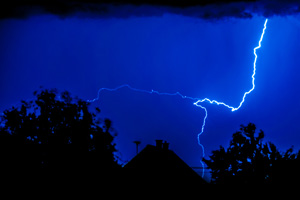If Lightning Roars, Go Indoors

Many cloud-to-ground lightning flashes have forked or multiple attachment points to earth.
Summer is the peak season in the U.S. for lightning, with strikes killing an average of 51 people per year, according to the National Weather Service.
In fact, just last month one person was killed and 13 were injured in a lightning storm at California’s famous Venice Beach.
John Griswold, M.D., Texas Tech Physicians Surgery, sat down with us to explain the effects of lightning on the body and what can be done to prevent such accidents.
Q: What happens to a person that is struck by lightning?
A: There are two things that happen when a lightning strike is a direct hit to a person, but first we must understand that this is incredibly high electrical energy in the range of 10,000 to 100,000 volts (compared to the strongest high tension power lines that are at most 7,000 to 8,000 volts and household outlets are 110 volts).
Those two things are:
- The electricity cooks the body’s tissue to extremely high temperatures.
- The electricity, as it passes through the body, drills tiny holes in the cells, tissues and organs it traverses called electroporation.
The only good news about lightning strikes is that the energy is only in contact with the body for a microsecond, and that allows some people to survive.
Q: How are injuries treated?
A: If the person suffers severe injury, the main thing that happens is that their heart stops and they quit breathing.
So, the main treatment usually is CPR. If they respond, then we monitor them in the burn intensive care unit for the tissue injuries.
Unfortunately, most people do not survive or cannot be revived from a direct lightning strike.
Q: What can a person do to avoid injuries?
A: To avoid injury when lightning and/or thunder are in the area, one must take shelter and not under tree, but in an enclosure completely protected.
What we mostly see, if the person survives lightning strikes, are not direct strikes, but what is called "side flashes" where something next to the person (like a tree) gets struck, electrifying the area and causing a weaker electrical injury, or more commonly, heating the surrounding ground and air to very high temperatures and causing third-degree burns.
Q: Anything as a physician you want to warn people about lightning strikes?
A: From a physician’s point of view, if you are with someone who does get hit by lightning, the best thing to do is check to see if they have a pulse, and if they don't have one, start CPR immediately and call 911.
Related Stories
Celebrating Veterans: TTUHSC’s General Martin Clay’s Legacy of Service and Leadership
From his initial enlistment in the Army National Guard 36 years ago to his leadership in military and civilian health care management roles, Major General Martin Clay’s career has been shaped by adaptability, mission focus and service to others.
Texas Tech University Health Sciences Center School of Nursing Named Best Accelerated Bachelor of Science in Nursing Program in Texas
The TTUHSC School of Nursing Accelerated Bachelor of Science in Nursing (BSN) program has been ranked the No. 1 accelerated nursing program in Texas by RegisteredNursing.org.
TTUHSC Names New Regional Dean for the School of Nursing
Louise Rice, DNP, RN, has been named regional dean of the TTUHSC School of Nursing on the Amarillo campus.
Recent Stories
TTUHSC’s Hudson Set to Serve as President for Society of Clinical Research Associates
The Society of Clinical Research Associates (SOCRA) has elected Texas Tech University Health Sciences Center’s (TTUHSC) Catherine Hudson, Dr.P.H., as its president for 2025-2026.
Clinical Research Institute a Source of Pride for Retiring Griswold
Upon his retirement, John Griswold, M.D., reflects on the Clinical Research Institute and what it has achieved.
Abid Brings Hematology Expertise to TTUHSC Oncology Team
Muhammad Bilal Abid, M.D., has joined the TTUHSC School of Medicine oncology team as an associate professor of internal medicine and medical director of TTUHSC’s Blood and Marrow Transplantation & Cellular Therapy Program.
